Bastar Chhattisgarh… Tribes of Bastar… Tribal markets… Chapura chutney… Chitrakoot falls…
There were just a few lines in the travel guides when I landed in Jagdalpur Chhattisgarh for the first time in 2012.
The ancient princely state of Bastar, now Bastar district, bordering the tribal state of Odisha, seemed a paradise for intrepid explorers.
My amateur ethnographer soul couldn’t resist for long.
After checking some Indian websites, my decision was taken: I will join Jagdalpur for Bastar Dussehra.
I could not imagine how I would fall in love with the Bastar tribes culture and the people of Bastar…
In this article, we’ll first talk :
- About the big concern of most travellers who want to visit Central India: is Bastar district safe for tourists?
- Then I’ll tell you why is Bastar tourist place so famous in Chhattisgarh,
- The Bastar art you should not miss as it’s an integral part of Bastar culture,
- The main festivals,
- The famous food.
- The information you need to prepare your trip
- What is the history behind the Bastar district in Chhattisgarh.
Click here to download your FREE Indian destinations guide!
Article summary.
Is Jagdalpur safe for tourist activities? What about the rest of the district?
If you are planning to visit Bastar, you may have heard of the Naxalite movement that has shaken India for over 40 years.
If you have Indian friends and tell them of your intention to go to Bastar, you will certainly hear about the Naxalism in India!
So, what is the Naxalite or Maoist rebellion in India and is Jagdalpur safe for tourists? In short, is it safe to travel to Bastar?
What is Naxalism in India?
The Indian Maoists, also called Naxals or Naxalites, have managed to create a red corridor stretching from Nepal to southern India and the Chhattisgarh is right in the centre.
This movement, created by a former member of the Indian Communist Party from the Bengali village of Naxalbari, is inspired by Mao Tse-tung’s revolutionary techniques to try to seize power.
Since 2004, the movement has imposed itself militarily in the tribal areas of the central-east.
Without going into details, Chhattisgarh is economically very interesting since it produces 30% of the country’s aluminium, 27% of steel, 16% of iron and 15% of cement.
Its GDP has increased by 95% in 10 years…
The districts of Bastar and Dantewada are – I’m tempted to say “were” – particularly affected.
If you want to know more, below is a book on the topic. Continue your read to know what was my experience with security there.

Is it safe to travel to Bastar? Are Jagdalpur hotels safe?
In 2012, I spent about 2 weeks there.
In 2015, I stayed there for 5 weeks.
In 2018, I stayed again there for 3 weeks.
That means I have spent more than 2 months in the district, going in many remote places, especially during my last trip in 2018 where I was staying in a Tribal village and was at a few kilometres of the Naxals’ headquarter in Dantewada district.
During this 3-month trip in India, I also visited several North-Eastern states, especially Arunachal Pradesh.
During my second trip, I was on the front page of local newspapers, on television or on the radio every day.
People recognized me and called me when I was walking in the street, asking for selfies with me.
In short, I became very popular in the space of two trips because of my commitment to tribes and traditional cultures.
And although I travel alone most of the time, I have never felt insecure, either in Jagdalpur, taking local buses, visiting a tribal village market or going to the jungle.
However, I have always followed the advice of the locals, at least more or less. When it came to “advice” that had nothing to do with the Naxalites, I had no real reason to follow them blindly.
In 2012, I did not visit Tirathgarh Falls, which were considered unsafe. In 2015, I was able to go and spend a long time there safely.
On the other hand, I went by bus to the tribal village of Dharba in 2012. In 2015, I was strongly advised against it.
In 2018, the situation had greatly improved. I’ve stayed in the only guesthouse in a Tribal village with my local guide friend. We have even travelled on his motorbike in the most remote and unexplored parts of Kanger Valley. As I’ve also said earlier, I’ve spent a few days in Dantewada district, slept in Dantewada and went into the jungle at a few kilometres from the Naxalites’ headquarter without any trouble. I only avoided saying where I was.
Locals know the places to avoid and they will always be good advisers. Listen to them!
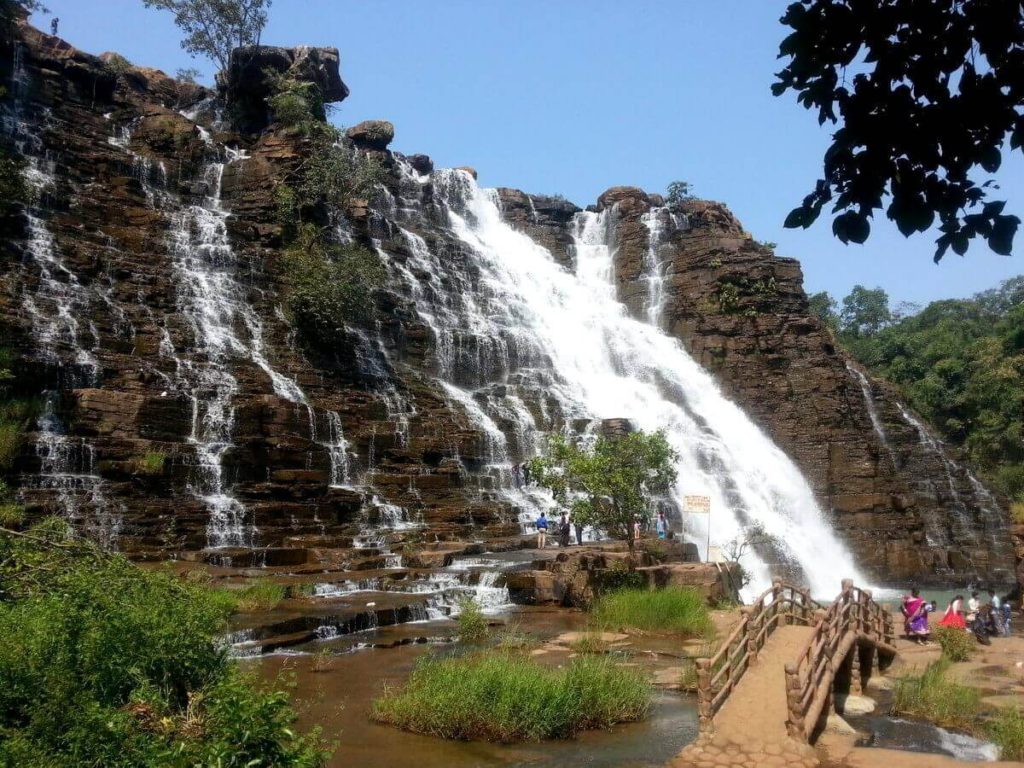
Make it clear to yourself that this conflict is not yours and that you do not have to know who is right. Do not comment on this situation.
The target of the Naxalites are the police and soldiers. Tourists don’t matter, even those like me who are quite popular.
As for the authorities, they hunt down Naxalite supporters among the tribal population and have no reason to bother you.
If you stay out of the conflict, you have no reason to find yourself in trouble.
A new tourist police has even been created recently in order to help the tourists who would need anything.
However, as everywhere, even at home or crossing the street in your neighbourhood, there is no such thing as zero risk. Unfortunately, Nice and Paris could experience it first hand.
Which are the best places to visit in Bastar, Jagdalpur and around?
I’ll first introduce you the most famous waterfalls of Bastar: Chitrakoot falls. I’ll tell you about the national park in Bastar and Tirathgarh waterfall, the villages and markets, the places to visit in Jagdalpur and I’ll finish with some tourist places near Jagdalpur but outside Bastar district like Dantewada, Barsur or Kondagaon.
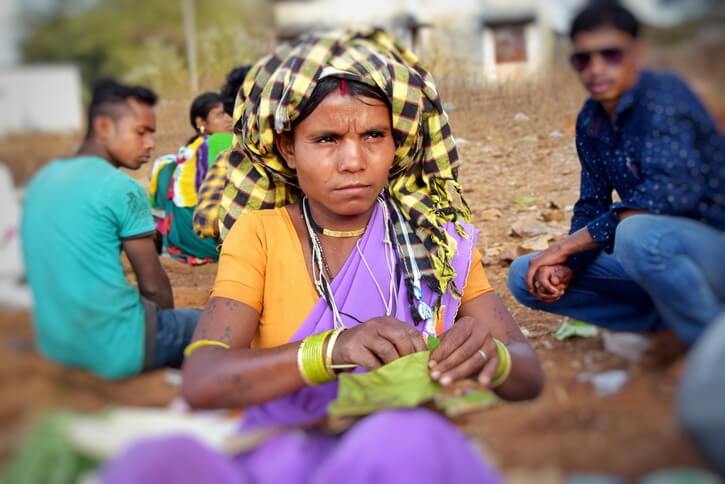
Chitrakoot falls.
Although I regularly visit Chhattisgarh since 2012, I always make sure to pay a visit to the famous Indian Niagara falls, Chitrakoot falls, that you will also often see written as Chitrakote or Chitrakot. Quite confusing when you know there’s another Chitrakoot in Madhya Pradesh!
The fall is called the Indian Niagara falls because of its horseshoe shape. It is 28 metres high and 305 metres wide. It has almost always a beautiful rainbow to complete the picture.
How to reach Chitrakoot falls?
The falls are located approximately 42 kilometres from Jagdalpur. It’s better to go on a market day so that it’s easier to find a shared three-wheeler to go. Jagdalpur to Chitrakoot falls bus can be tricky to find. If you have your own vehicle, you can combine a visit to Chitradhara and Tamdaghumar, two other waterfalls on the way to Chitrakote. I even recommend you to stay there at least for one night. Unfortunately, the luxury tents of Chitrakote resort have been destroyed by the wind. You can stay in one of their cottages operated by Chhattisgarh tourism board. This option is recommended only if you can get the one with the view of the waterfalls as it’s quite expensive for the level of service. Or you can stay in the Tribal camp close to the falls offered by the travel agency Unexplored Bastar (contact me first to get a discount).
From Raipur, you’ll have to drive 250 kilometres to reach the waterfalls.
Where are Chitrakoot falls located?
They are located west of Jagdalpur towards Barsur (important historical centre mentioned below), after the village of Lohandiguda which has a superb market.
Do not hesitate to combine the two visits!
You will find in order: Chitradhara Falls – Lohandiguda – Chitrakoot Falls – Tamdaghumar Falls – Mardum (Mardoom) and finally Barsur (Barsoor).
Best time to visit Chitrakoot falls.
It’s best to visit just after the monsoon, in October. That means you can also combine with Bastar Dussehra (see the related section below). But the monsoon is also a good period as you will see the big flow of the muddy fall.
My visits to Chitrakote falls.
In 2012, I combined my visit to Chitrakot waterfall with the beautiful Lohandiguda Tribal market. I could easily find a shared tuk-tuk to visit the market, then another one for the falls. I did the same for the return as I was invited for the dinner by a family living in Jagdalpur but working in the market. I could have a bath alone at the top of the falls and could see several religious sanctuaries, especially a Tribal one with beautiful idols.
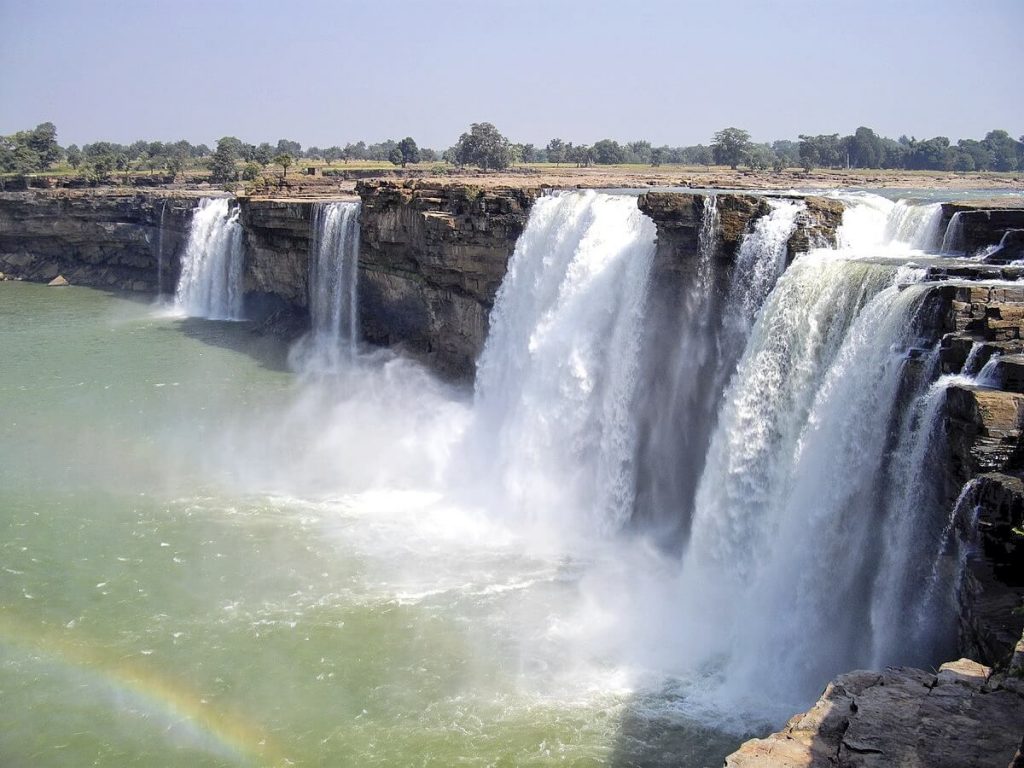
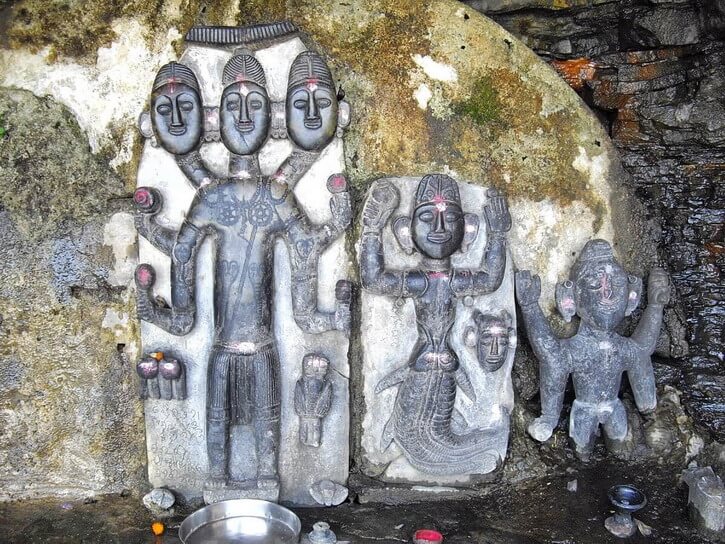
In 2015, I arrived directly by car from Barnawapara reserve in the north of Chhattisgarh and I have stopped here for one night. I could enjoy the beauty of a luxury tent. As I told you above, it’s now destroyed.
A few weeks later, I was back for the sunset with some of my local friends. We couldn’t access the Tribal sanctuary as it’s now too dangerous. Recently, when one of my local contacts saw my pics, he realised that the idols he had seen in a private collection came from here. Apparently, the idols have been stolen and some people know where they are!
In 2018, I was back in Chitrakote for the local festival, shoot the pic of this beautiful Tribal woman below and interact with the officials and organisers. Otherwise, this fair is not so interesting.
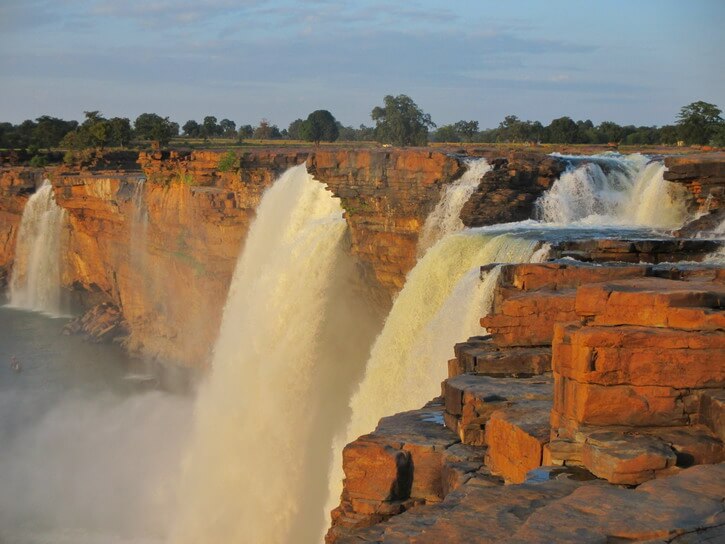
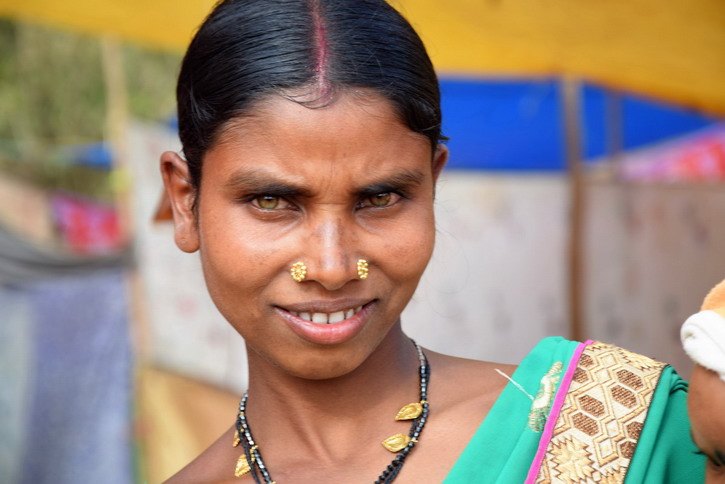
National Park in Chhattisgarh: Kanger Valley and Tirathgarh waterfall.
As I told you above, my first visit to the National Park of Bastar, Kanger Valley, and Tirathgarh waterfall was in 2015. Bastar forest in this area is now more secure than it was before.
How to reach Kanger Valley National Park and Tirathgarh waterfall?
The main entrance of the National Park, Kutumsar gate, lies 27 kilometres south of Jagdalpur. There are some direct buses to Kanger Valley but be aware that Tirathgarh waterfall is at 7 kilometres from there. So it’s better to have your own vehicle if you don’t want to hitch-hike or walk.
Where are Kanger Valley National Park and Tirathgarh falls located?
The park extends over 200km². Tirathgarh Falls is located southwest of Jagdalpur but the park extends east to the border with the neighbouring state of Orissa (Odisha).
Best time to visit Kanger Valley.
Beware as the park is closed from 1st July to 31st of October. Opening time: 8am-4pm. Nevertheless, Tirathgarh waterfall is always available and the park is 200 kilometres square. Some parts of the park are free. The best time to enjoy the park is winter as it’s time for the migratory birds to visit it.
What to see in Kanger Valley National Park?
Bastar forest is famous for its fauna and flora. In the notable wildlife species, we can find leopards, wild cats, barking deer, black bears, flying squirrels, wild rabbits, jackals, striped hyenas, colourful lizards, pythons. If you’re very lucky, maybe you will see the wild buffalo, jungle fowl, drongos or the famous Bastar hill myna, the state bird with its human voice! Bastar hill myna has been so hunted for this skill that it’s now endangered and protected.
It’s also the only region in peninsular India that has pockets of virgin forests.
Several caves can be visited:
* Kutumsar cave, discovered in 1900, whose main entrance is 330 metres long and 20-72 metres wide. It contains magnificent limestone stalactites, stalagmites and a Shivalinga stalagmite you will see with the help of a guide and solar lamp. Don’t miss the water collection where a blind fish species live.
* Kailash cave, found in 1993, that is 200 metres long and 30-35 metres wide. Its name comes from Kailash Mountain because of its shape. The stones and stalactites look like chandeliers and the clash of rocks and limestone provokes a kind of music when you reach the Music Point.
* Dandak caves, found in 1995, are 200 metres long and 15-25 metres deep. The stalagmites and stalactites here are so symmetric that it looks like sculptures.
Tribal people and their connection with nature: the story of a barking deer rescue.
In February 2018, I’ve spent time exploring some new places. After visiting Shakeel’s farm and Nangur market again – I absolutely wanted a tribal tattoo to show my support to the Tribal people, we reached the house of a Tribal family for dinner. While Shakeel was preparing the chicken, I accidentally talked about a pork breed common to my area in the Basque Country and Bastar. Immediately, our host asked us to follow him in the neighbouring house. There, in the only room of the house, hidden under the bed, we saw a barking deer baby! The neighbour had found him in the forest. The baby had lost his mother and had been bitten by a dog. The couple who rescued him was feeding him and had tied an amulet made of human hair around his neck. We took him in our arms and tried to cheer him up. Shakeel called the rescue association he is part of, asking them to come early on the next morning.
On the next morning, we had no news. Shakeel began the day cleaning the poor baby, feeding him and giving him vitamins. Then he called another guy who returned from Odisha especially to rescue him in Nangur. In the meantime, we gave a lot of hugs and love to the baby who was now feeling safe with us. He even asked to come on my legs when I was sitting close to him. After a while, he came on my chest and fell asleep. It was such a magical moment!
The officials of the forest department joined us with a ranger and a pet doctor. After a check-up, they took him to the park at the entrance of Jagdalpur. Luckily, we arrived there at the same time and could see the baby arriving in his new home.
Unfortunately, according to them, it won’t be possible for him to return to nature. After a few months, he joined an Indian deer park.
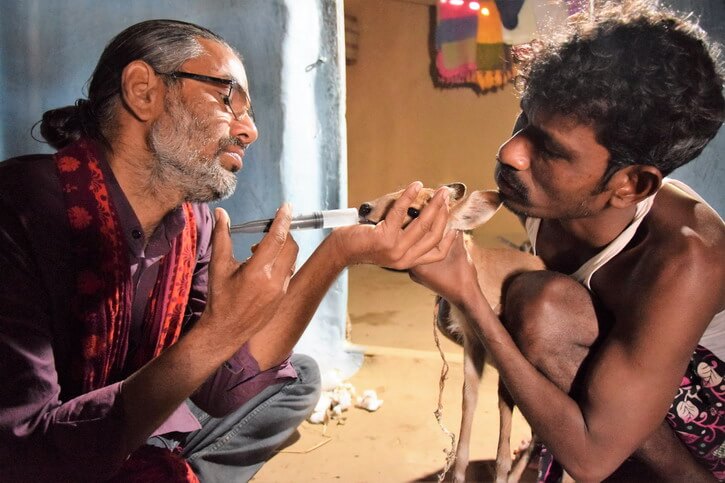
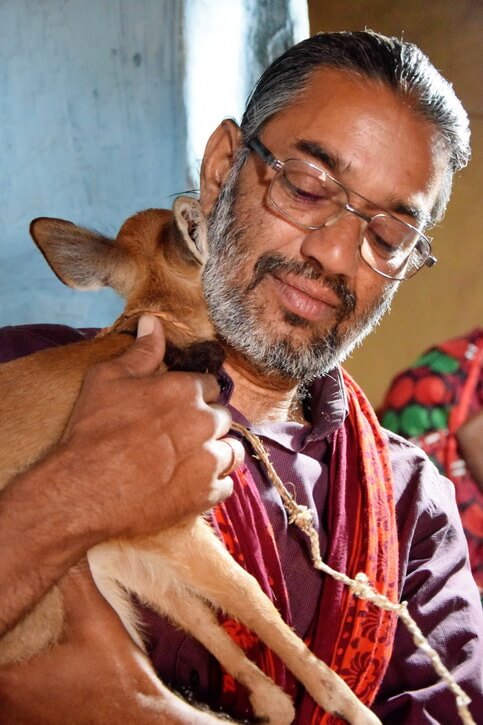
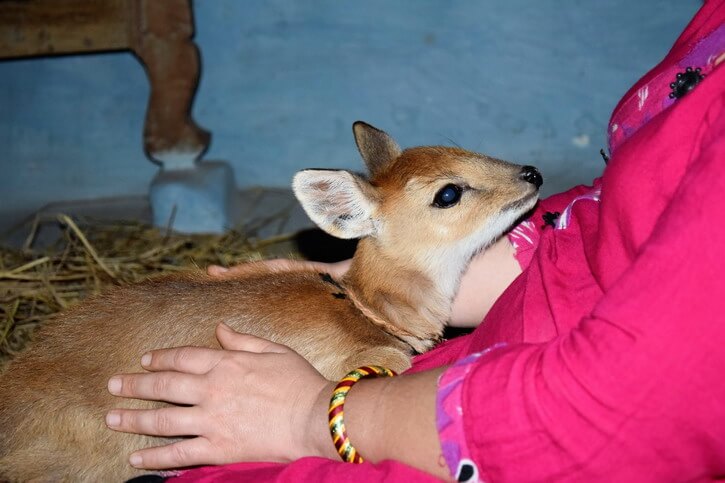
Jagdalpur tourist places.
My favourite places to visit in Jagdalpur city are Sanjay market and Bastar palace. But there’s more to discover in the town.
Best time to visit Jagdalpur.
Of course, the best time to visit Jagdalpur city is during the World’s longest festival, Bastar Dussehra, especially the last days corresponding to Navrati and often a few days after. In 2018, Navratri will start on the 10th October.
What to see in Jagdalpur?
* Sanjay market. The main market day is on Sunday but Sanjay market can be visited any day. My favourite photo model often sells vegetable there and the sellers are extremely friendly as everywhere in Chhattisgarh. Generally, I even don’t need to ask people for a pic as they ask me! In 2015, I spent my last afternoon there and the female fish sellers asked me to shoot and print their pics. I had to go to the photo studio many times and it was a nice interaction.
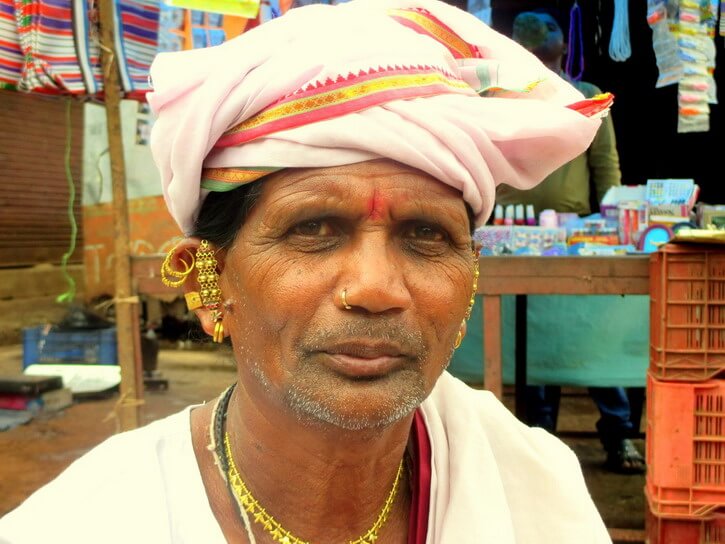
* Bastar palace and Danteswari temple. The beautiful palace of the Maharaja and its Danteshwari temple can be visited freely. It’s impossible to miss the big white and orange entrance gate on Palace road. It’s the central place for the rituals of Bastar Dussehra. In front of the temple, you can also visit Jagannath temple. In the hall of the palace, you will see the Raja’s throne and the photos of the previous Maharajas. The main pic is Maharaja Pravir Chandra Bhanj Deo, the grand uncle of the actual Maharaja, Kamal Chandra Bhanj Deo. He was the first Oriya ruler and the 20th Maharaja of Bastar State. He was killed in the palace in 1966 with many Tribal people by the police. People say that Madhya Pradesh Congress and the English rulers didn’t appreciate his power and his way to defend the Tribal cause. It would be the reason for his murder.
During Dussehra, people come to Danteshwari temple to have their vehicle blessed or for the first cutting hair ceremony, mundan. It’s a propitious time.
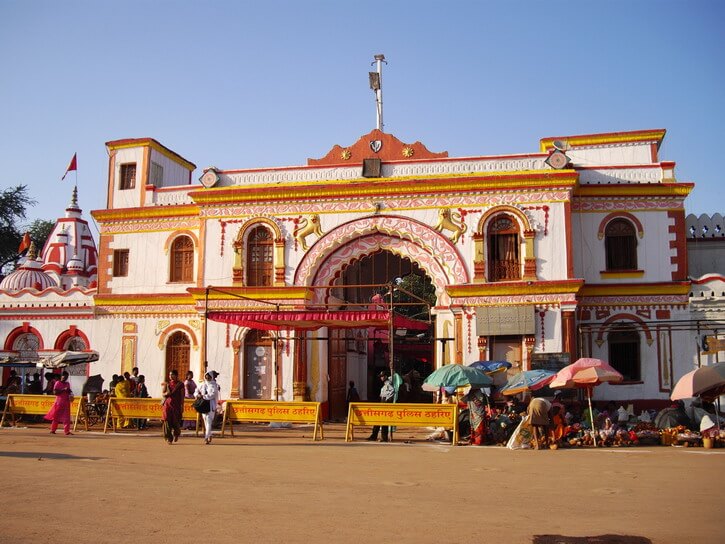
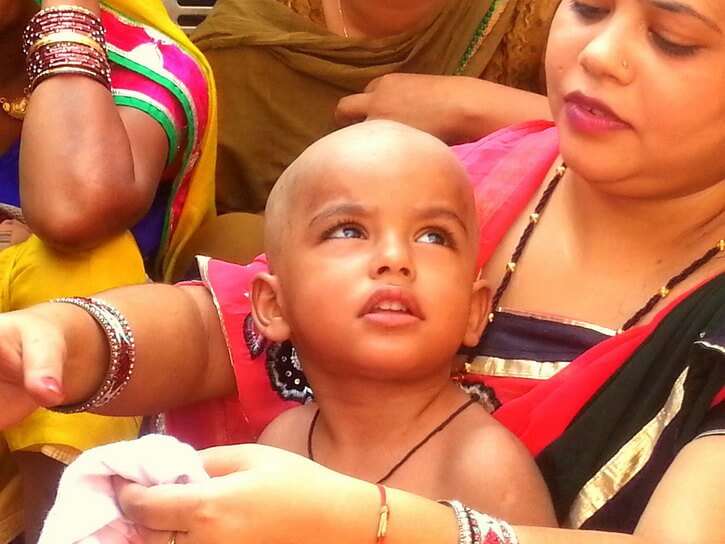
* Balaji temple, Dalpat Sagar Lake and Anthropological Museum. As Balaji temple is on the way to the museum and close to Dalpat Sagar Lake, you can combine the three visits.
Lord Balaji is considered as the creator of the Universe. It’s also one of the forms of Lord Vishnu. That’s why you will find statues representing all the forms of Vishnu God at the top of the outside wall. It’s a beautiful temple with pastel colours and a cart form.
Dalpat Sagar Lake is one of the biggest artificial lakes in Chhattisgarh. It was constructed by Raja Dalpat Deo Kakatiya around 400 years ago. The local people enjoy fishing here in early morning and you can come at sunset to shoot beautiful pictures. There’s a Shiva temple in the middle.
The Anthropological Museum deserves a visit to learn more about the Tribal culture, understand the different rituals of Bastar Dussehra, see on a map where the different tribes live, memory pillars and unique dhokras (bell metal statues) and terracotta pieces.
Tourist places near Jagdalpur – Bastar markets.
Before I heard about Chhattisgarh, my idea in 2012 was to discover the life of Tribal people in Odisha through its weekly markets.
Although this state has much to offer and perhaps better infrastructure, Chhattisgarh actually turns out to be much easier for a foreigner to explore, since no permits are required. As each village and market, also called haat, in the district is interesting to visit, I’ll only give you a list of my favourite ones with its localisation on the global Bastar map and its market day.
Only a few markets like Tokapal and Lohandiguda can be quite easily reached by your own. It’s recommended to have your own vehicle and guide as often even the locals are lost!
Where is Bastar district? Bastar map.
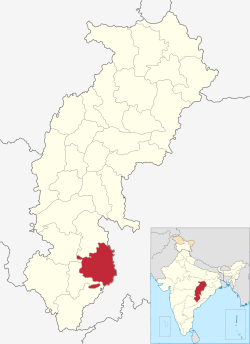
Nangur market.
Nangur, at about 20 kilometres from Jagdalpur, is my favourite market. It’s very difficult to find a local transportation to go there. That’s why the best option is to stay with the locals in the village! The market is on Friday.
Why Nangur market is my favourite: it’s a beautiful big market with sand lanes, there are only mud tribal houses around, you will really feel in a remote place, there’s a lot of places to visit around Nangur, you will meet a lot of Bhatras and Dhurwas wearing their traditional clothes and unique tattoos, it borders Kanger Valley National Park and my friend Shakeel lives close to Nangur.
Warning: if you want to see cockfighting, it’s really better to be with a local. Although in 2012 in Tokapal, I had no problem, it has been different in 2015. When I’ve reached the ground and started shooting, I quickly understood I wasn’t welcome. It can be easily understood as I could have been an informer and cockfighting is not allowed. On the opposite, in 2018, I was with Shakeel in Nangur and the locals asked me to shoot them with their cocks.
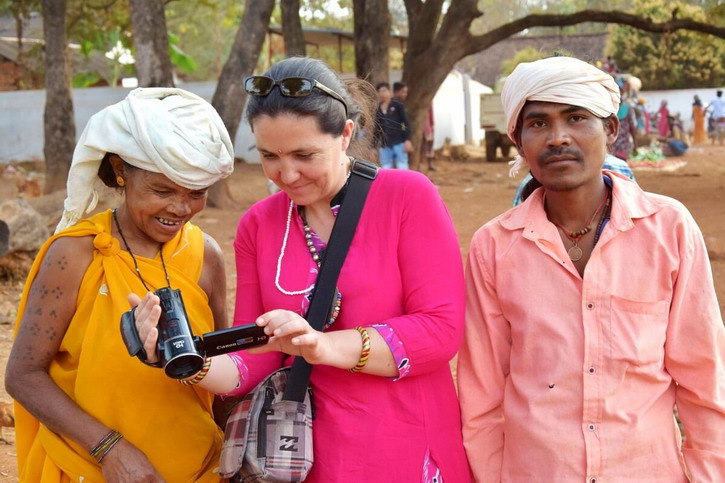
Lohandiguda weekly market.
Lohandiguda haat is one of the biggest of the district. It’s also on Friday. Plan your visit to Chitrakoot falls on the same day, especially if you travel by your own. Tribal people here sell food and alcohol but also dokhras, roosters, etc.
Tokapal weekly market.
Tokapal haat is on Monday. Tribal people here particularly love pictures and they will certainly ask you to shoot them with their stalls. It’s quite easy to reach the market with the local transportation. Each time I visit, I return with a lot of awesome pics.
Bastar weekly market.
Yes, that can be confusing: there’s also a village in the district that is called Bastar!
Bastar haat is on Thursday.
Close to the market, you will find a Tribal park showcasing the Tribal culture and a kind of Tribal village where people live and learn handicraft. There’s also a shop selling a lot of very beautiful dokhras (bell metal statues made by using the lost wax method).
Tourist places close to Bastar district.
Jagdalpur to Dantewada.
Dantewada district is less explored than Bastar district although several places of interest can be found.
I recommend you go there on Sunday and visit the beautiful Geedam market, a big market where the tribes wear jewels and tattoos very different from Bastar district.
On the way, don’t miss the memory pillars. These unique tribal monuments are erected in the memory of the deceased family members and tell their life through paintings.
The main attraction of Dantewada is Danteshwari temple. The black statue of the most important Goddess of the region, Danteshwari, can be seen inside the temple. It is said that the temple has been built here on the order of the Goddess, who was following the Kakatiya King, Amman Dev from Warangal, during his conquest of the region. During Dussehra, the Goddess leaves the temple to join her twin sister in Jagdalpur. The procession led by the Bison Horn Marias is one of the most beautiful and colourful events of Dussehra.
The temple is also one of the 52 Shaktipeeths, known as being the spot where Sati’s tooth fell after Shiva danced the tandava with her immolated body. That means it’s one of the major shrines and pilgrimage destinations in Shaktism, the Goddess-focused Hindu tradition.
Although you can find a bus to go to Dantewada, you should really go with a guide or local. In 2012, they didn’t let me enter the main sanctuary and I couldn’t see the Goddess. I had a very bad experience in the temple with the local police and the teenage security guards. One of them even took my bag containing my HD video camera. I was so upset that I left and even refuse the lunch invitation of the other locals.
In 2015, the local reporter for DD News, Sunil Panday, knowing my bad experience in Dantewada, took me for a whole interview day there. I even had the extraordinary privilege and honour of sitting close to the Goddess. Only the royal family and priests are normally allowed there.
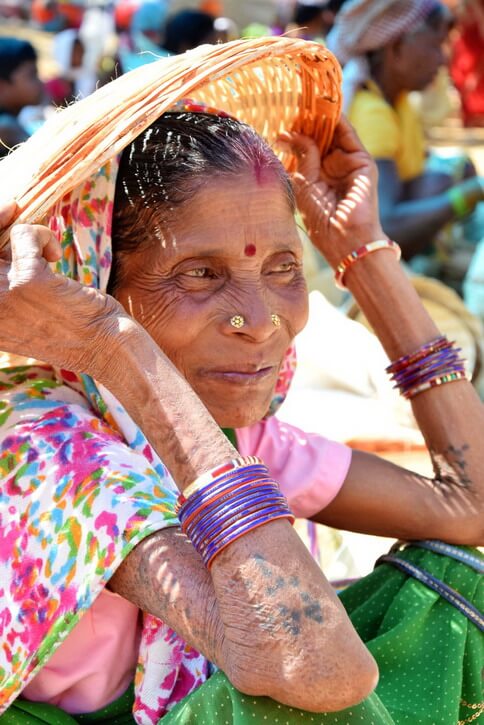
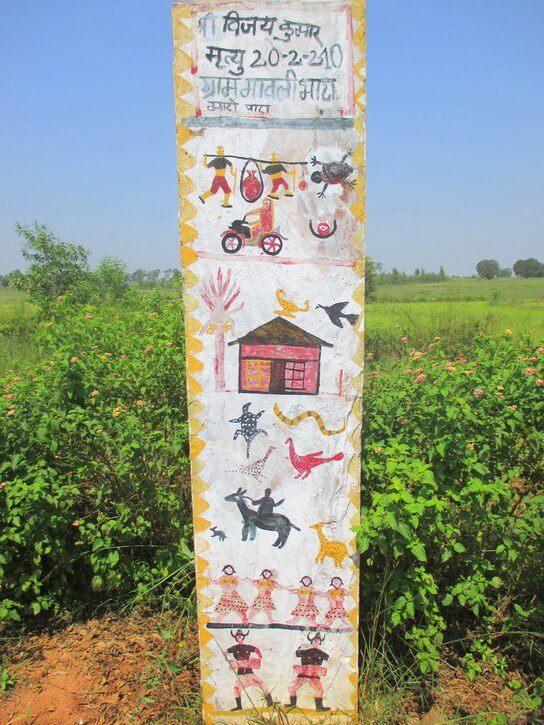
Barsur.
Barsur is a fascinating place.
Legends say that the erstwhile stronghold of the Nagavanshi rulers had 147 temples and ponds.
The best time to visit Barsur temples is during winter (October-December). As you can see on the map, you can easily combine your visit to Geedam market and Dantewada temple with Barsur (84km from Jagdalpur, 33km from Dantewada). But if you want to add the trek to Dholkal, you will have to spend one night in the very basic Transit Hotel in Dantewada or sleep in a tribal guesthouse.
Ganesha Temple is certainly the most famous one with its twin Ganesha, the elephant-head God, statue.
But the place that will certainly fascinate you the most is Battisa temple. This 32 pillars Shiva temple has two Shiva lingams whose base can be turned! People believe these lingams are two keys belonging to a complex system opening a treasure room…
Pedamma Temple should seem an insignificant shrine. It would be actually the first place where King Amman Dev from Warangal stopped with Goddess Danteswari. The initial temple wouldn’t be Danteshwari temple in Dantewada but Pedamma in Barsur!
Mama-Bhanja Temple should have been a Vishnu temple. It has never been finished and consecrated as the nephew had made the temple without the consent of his King uncle. The King died in a bloody battle between them and the nephew never finished the temple.
Solah Khamba Temple was a 16-pillared temple.
Chandraditya or Market Temple has been built by a feudatory chief called Mahamandalesvara Chandraditya. Each Saturday, Barsur market is organised here. The place is especially beautiful at sunset time as it borders the lake. It has been repaired with different kind of statues. The original ones would be the erotic carvings.
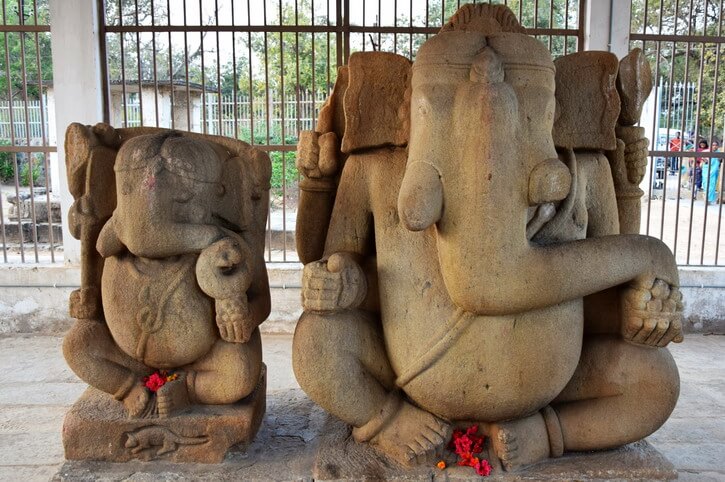
Dholkal Ganesha.
The 3-feet (1 metre) high elephant-head God statue has been discovered in September 2012 by a local reporter from Dantewada. It lies on one of the highest peaks of Bastar, at 3 000 feet (about 1 000 metres) high, in Bailadila forest range. You will absolutely need a local guide for the trek.
I have never done this trek but you can read the trek story of Indrani Ghose.
Kondagaon.
Kondagaon is located about 70 kilometres from Jagdalpur and can be easily reached by bus from Jagdalpur. It’s on the Jagdalpur – Raipur road. There are several hotels there.
The city is especially interesting for its weekly market on Sunday and has the most famous bell metal and wrought iron artisans of the area. If you’re interested in the unique handicraft of Bastar, you should not miss Kondagaon!
What is the speciality of Bastar? Bastar art and craft.
The district art and craft is closely related to the Bastar tribes culture. Many artisans have received a National and even International recognition.
Although you can see this handicraft in a shop or the process in a big structure, I strongly recommend you to ask Shakeel to organise you the visit. He will take you directly to the house of the artisans, you will see their work and will share their lunch.
Dhokra art, the famous bell metal of Bastar.
Dhokra, also written dokra, is the most famous Tribal art of Bastar.
The artisans use the ancient method of metal casting, passed from generation to generation. In 2018, I could see the whole process with a local family in which everyone had their own function.
Each piece is unique as the mould is broken to get the bronze statue. It often represents tribal themes.
On the pic below, you can see the main statues are a tribal couple with their babies. The man wears the traditional turban and the tumba, the refreshing gourd made from a vegetable. They both wear the Tribal ornaments corresponding to their sex. Notice the anklets of the woman.
On the left, you can see another dokra with people collecting salfi from a salfi tree.
Contact me if you can’t visit Bastar and want to buy a dhokra. I have a small stock at your disposal.
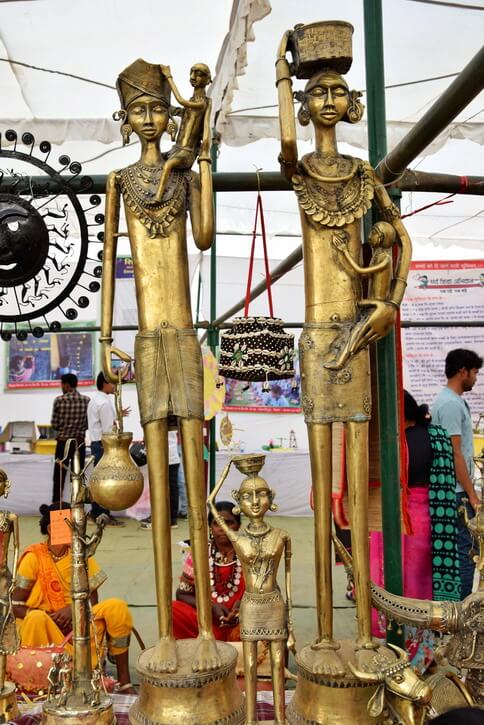
Wrought iron.
Wrought iron is something you will also see everywhere in Bastar: slim tribal dancers or musicians, animals, sun, mirror frames, candle stands… Their design makes them unique.
Bastar art furniture.
If you’re invited into a house, you will certainly see a lot of wooden furniture covered by the scenes of the tribal life, especially the Bison Horn Marias.
Of course, you will also see plenty of shops on the main commercial street of Jagdalpur selling woodcraft.
Terracotta and clay work.
Very simple for the everyday items or very elaborated for the house protection, the prayer or decoration. Terracotta and clay work are used since immemorial time in the district.
Bastar art painting.
You will see the most ancient ones on the memory pillars, on the wall of the villages, less often on tribal houses. Now it’s often replicated on canvas.
Weaving, kosa silk, godna and sisal.
If you wander around the tribal villages, you will certainly notice the hanks prepared by the tribal women. They use the threads to make towels, saris, bedspreads.
On the market, you will see some men selling cocoons (kosa) collected off saja, sal and Arjun tree. The silk is used to make sarees.
Godna, the tribal tattoos of Central India are replicated on fabric. A way to preserve this art that is slowly disappearing…
Sisal or agave is used to make dolls, coasters, bags, etc.
Original lamps.
You will find some lamps made from tumba or tuma. The hollow gourd shells used by the tribal people to preserve liquor is now decorated and reused as a lamp.
Which is the main festival in Bastar? Bastar Dussehra, the main festival of Chhattisgarh… and more!
The 75-day long Bastar Dussehra, less often called Jagdalpur Dussehra, is the World’s longest festival.
The festival starts in July with the Paat Jatra ceremony when the Tribal people of the region bring a big piece of sargi (saal tree) in front of Danteshwari temple in Jagdalpur.
It ends in October with Shri Danteshwari Mata Ki Bidai, the 75th day where Goddess Danteshwari leaves for Dantewada.
It’s my favourite Tribal festival in India, with Dandari in Telangana. It’s also the best time to visit Jagdalpur and learn about the the Tribes culture.
It involves the tribes of the area and their Maharaja in colourful rituals and processions.
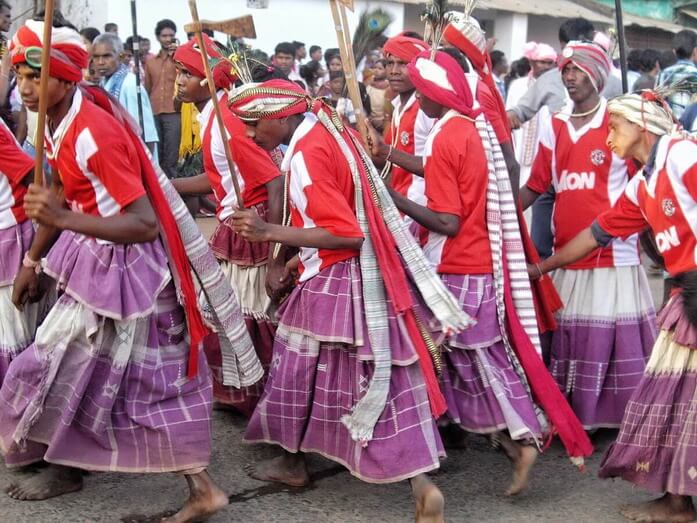
Below is a list of other festivals of Chhattisgarh you should consider:
Cher-Chera (Jan.) – the harvest festival of Chhattisgarh.
Narayanpur Madai (Feb.-March) – Here you will see some religious Abhuj Maad rituals.
Fagun Madai Dantewada (Feb.-March) – during this 10-day long festival, the Tribal people carry their local Deity to Danteshwari Temple in order to reunite the family of their main Goddess. It’s one of the main festivals of the area.
Goncha (July) – the chariot festival of Jagdalpur (like in Puri). Tribal people use a bamboo pistol with a “goncha” fruit as a bullet.
Hareli (Aug.) – Farmers’ festival with different rituals and attractions as the worship of the tools and races on bamboo stilts.
Pola (Sept.) – Bullock worship and races.
Barsur (Jan.) and Chitrakote (Feb.) Mahotsav – more similar to cultural and commercial fairs.
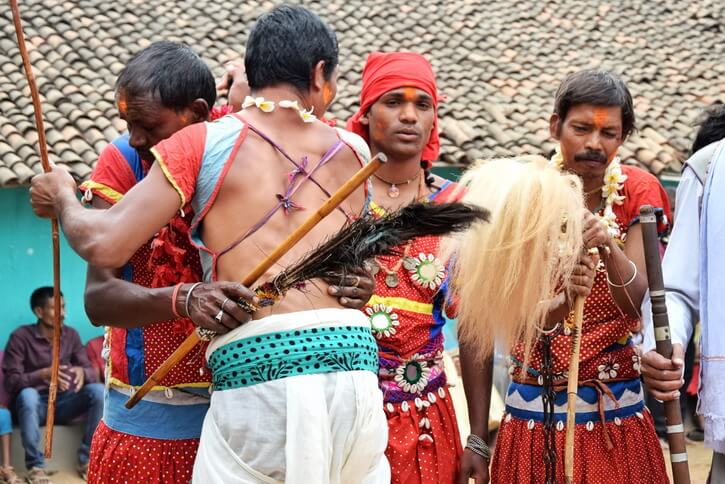
Chhattisgarh famous food and drink.
You will see plenty of vegetables and fruits in the markets: potatoes, jackfruits, roots, tomatoes…
Cereals are an important part of the diet: rice, corn, kosra (foxtail millet), madiya (finger millet). It’s also used to prepare “bobo”, a sweet snack made from rice and lentils.
All kinds of meat are consumed: chicken, crab but also rabbit, reptiles, rat. In 2018, I should try field rat and crabs pressed to extract the juice. Unfortunately, our tribal friend couldn’t catch a rat. Shakeel told me the taste is quite similar to rabbit.
My “Chapura” experience:
Chapura is used both to describe the red ant species Tribal people eat but also the chutney they prepare with the ants.
I’ve tried it alive for the first time in 2012, after failing once. I was too afraid…
The second time, I chose the ones that didn’t move, crushed it between my fingers and ate it. The taste was both acid and sweet like tamarind but quickly became bitter. My awful grimace made the tribal ladies around me laugh a lot!
In 2015, Awesh took me to a tribal village where we could enjoy a chapura chutney with rice. I could see the preparation, including ginger, chilli and different spices. It was absolutely delicious. Chapura chutney would be very efficient against fever and cold.
In 2018, when I saw my first chapura ants in a market, I stopped thinking. I suddenly took a few alive and moving ones in my right hand and directly put it in my mouth. This is how I realised Shakeel was absolutely true. If you don’t crush chapuras, the taste is totally different and absolutely delicious, never bitter. Now, I always make sure to eat chapuras alive, even if I often feel the bites for several days!
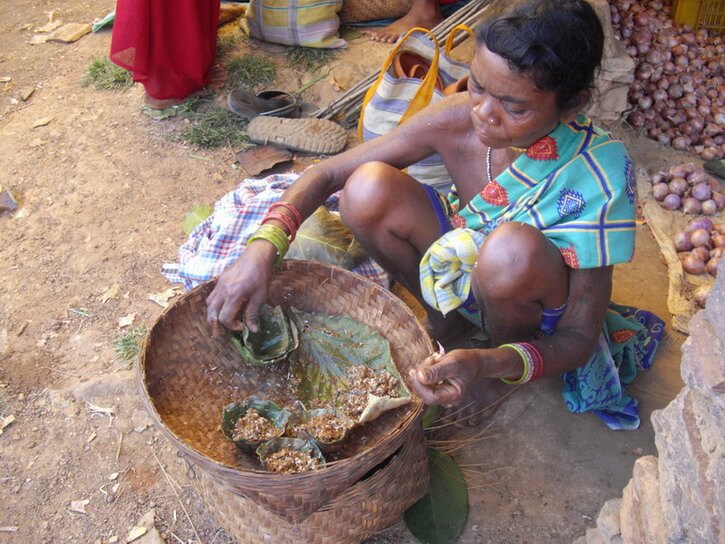
Tribal people are able to prepare alcohol from natural products.
Salphi is known as the Bastar beer. It’s collected twice a day, in morning and evening, from the salfi tree. Don’t be surprised if you see the Tribal women giving it to their babies: salphi contains alcohol only after a few hours fermentation. Tribal people think it cures diabetes and is an antiseptic.
Mahua flowers are not only used for oil. A strong alcohol is also made from it and you will often see flowers drying on the roof of the Tribal houses.
Landa beer is made from fermented rice and herbs.
Rusum is made with jaggery but is not easy to find.
You want to learn more about the food Adivasis eat in Bastar ?
Read the very informative comment of Manoj Sharma in response to my Facebook post below.
How to reach Jagdalpur?
The nearest airport is Raipur. The international closest airport is Vizag.
For your international flight, I highly recommend you my favourite Gulf company, Qatar Airways.
Book your flight from Delhi to Raipur or Vizag on Make Your Trip. Then book a private car or a public bus from this site also. Or book the train from Vizag to Jagdalpur and stop wherever you want – Araku Valley, Koraput, Jeypore.
>>> Check the timetables and availability here
Jagdalpur also has a railway station, connecting the city to Odisha (Bhubaneswar direction) and Andhra Pradesh (Vishakhapatnam-Vizag direction). Jagdalpur railway station is located in Railway Colony, at a few kilometres from the centre.
The city is well connected by road with some major cities. Raipur to Jagdalpur by road normally takes 6 hours for a distance of about 250-300km. But the new 4-lanes road built in 2017 makes it easier and quicker. If you travel by bus, you’ll find plenty of options from Jagdalpur New Bus Stand on New Bus Stand Road. Book on Make My Trip with the link above.
Jagdalpur hotels.
Jagdalpur hotels are the best choice if you come during Dussehra.
If you don’t come during Jagdalpur Dussehra, it’s better to stay with Shakeel in his tribal village (don’t forget to tell him you came after reading my blog for a special offer).
I’ve tested several hotels in Jagdalpur and here is a quick review. Note that, as hospitality is my main field of expertise, I don’t accept to be treated differently because I’m a travel blogger. I consider that the same service has to be provided to everyone and I also observe how other clients are treated by the staff… The conclusions below are not only the reflection of the way I’ve been personally treated.
* Hotel Atithi (2012), located close to the railway station, is the first place I’ve tried in Jagdalpur. It was absolutely awful: dirty, noisy, horrible and very far from the centre.
* Hotel Suri International (2012) was my second place. I’ve stayed there for a few days. It was clean, I had a big room but it was very expensive and far from the centre. Forget it also!
* Hotel Shradha Suman (2012) is well located in Power House. That means close to the Royal Palace and the centre. It was quite cheap and clean but was lacking comfort. The aircon was broken and I didn’t have European toilets. On my first day, a young guy asked me if I wanted a massage in my room… I stayed there mainly because it was very close to my friends’ house. Shradha Suman doesn’t accept foreigners anymore.
* Hotel Rainbow (2015) had been reserved for me by Chhattisgarh Tourism Board. Although I had a good internet connection and a big room where I could receive my friends and the journalists, I find the price too high and the service quite lazy. After the Director knew I was a travel blogger, each morning a huge staff was coming to clean my room… and always let the curtain fall down! The hotel is close to Sanjay market, in the centre.
* Hotel Ravi Residancy (2018) was my first stop in 2018. My first room was very dirty, noisy, without intimacy although I was paying 1 600RP. My second room was smaller, cheaper and better. As usual, I had to ask for everything. The kitchen on the top, where they prepare the breakfast, is so black that it’s incredible nobody is sick!
* Hotel Devansh (2018) lies at a walking distance from Sanjay market and the Palace, in the centre. The service was almost perfect. My room was big, quiet, clean and with a good smell. They offer a courtesy kit for the bathroom and office. The breakfast offers a large choice. According to me, it’s the best hotel in Jagdalpur. Note that I haven’t tried Hotel Naman Bastar and Bastar Jungle Resort. The internet reviews seem quite good but they are located far from the centre. Nevertheless, if you check Trip Advisor’s reviews, you will see that Devansh Residency is ranked n°1 in Jagdalpur.
Book you hotel on Make My Trip. You will find both Devansh and Rainbow hotels.
>>> Check the availability here
Jagdalpur weather.
October to May is the best period to visit the district as it’s outside monsoon time and there’s a lot of festivals. Note that April and May can be very hot. Generally, the weather during Dussehra is perfect, without rain or very high temperatures. Nevertheless, it can be very dusty and cause cold or dust allergy.
What is the history behind the Bastar District in Chhattisgarh?
The history of Bastar can be traced back to Ramayana! The area is mentioned as the Dandakaranya forest, the exile place of Lord Rama in the Ramayana, and Kosala Kingdom in the Mahabharata. This incredible connection can only give a special aura to the whole territory.
Bastar State was founded around 1324 by King Amman Dev from Warangal who was protected and followed by Goddess Danteshwari (see the story above and in my article about Dussehra).
Maharaja Pravir Chandra Bhanj Deo (1929–1966), the 20th and the last ruling head of the Bastar state, ascended the throne in 1936, before the independence and partition of India in 1947. As he was doing a lot for his people, he was a beloved and powerful King. In 1966, he was shot dead in a police action on the steps of his palace.
The actual ruler, Maharaja Kamal Chandra Bhanj Deo, is his grand-nephew. During Dussehra especially, he plays a major role, sometimes as the main priest like during Maoli Parghav, sometimes as the head of the whole community like during Rath Parikrama.
Conclusion.
I hope I’ve convinced you to visit my favourite part of India, Bastar district in Chhattisgarh State. Now you should be ready to prepare for your trip thanks to all the information in this article!
And you, have you also already visited a place that left you with the need to return again and again and learn more and more? Or have you met a community that convinced you to dedicate your time to them? Contact me if you want to share your experience in a guest post.
Read more: My travel guide to Chhattisgarh.

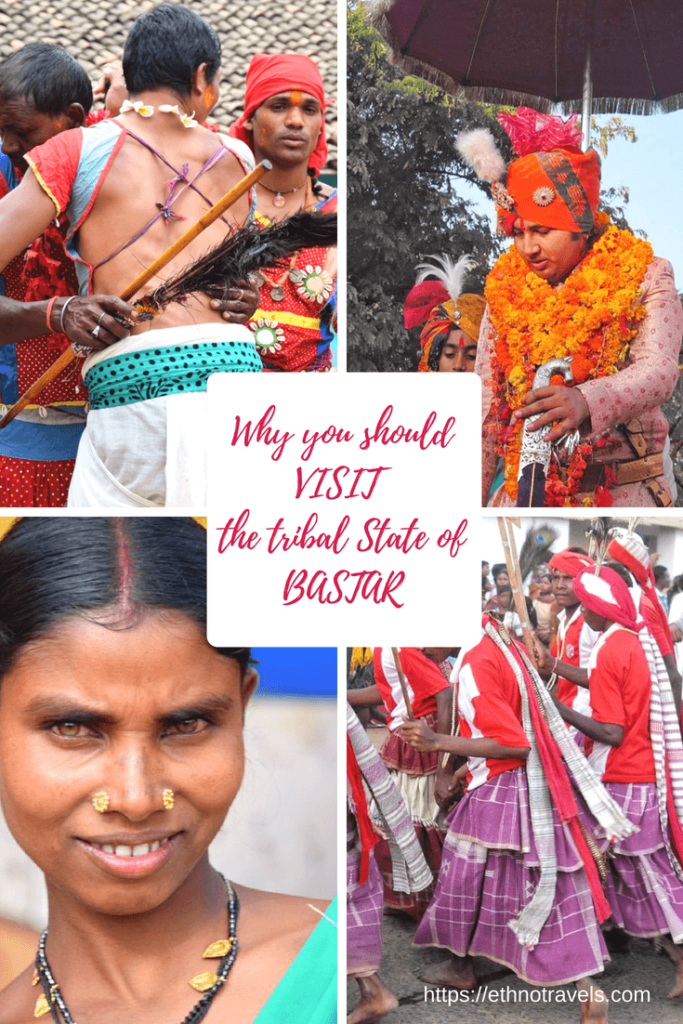
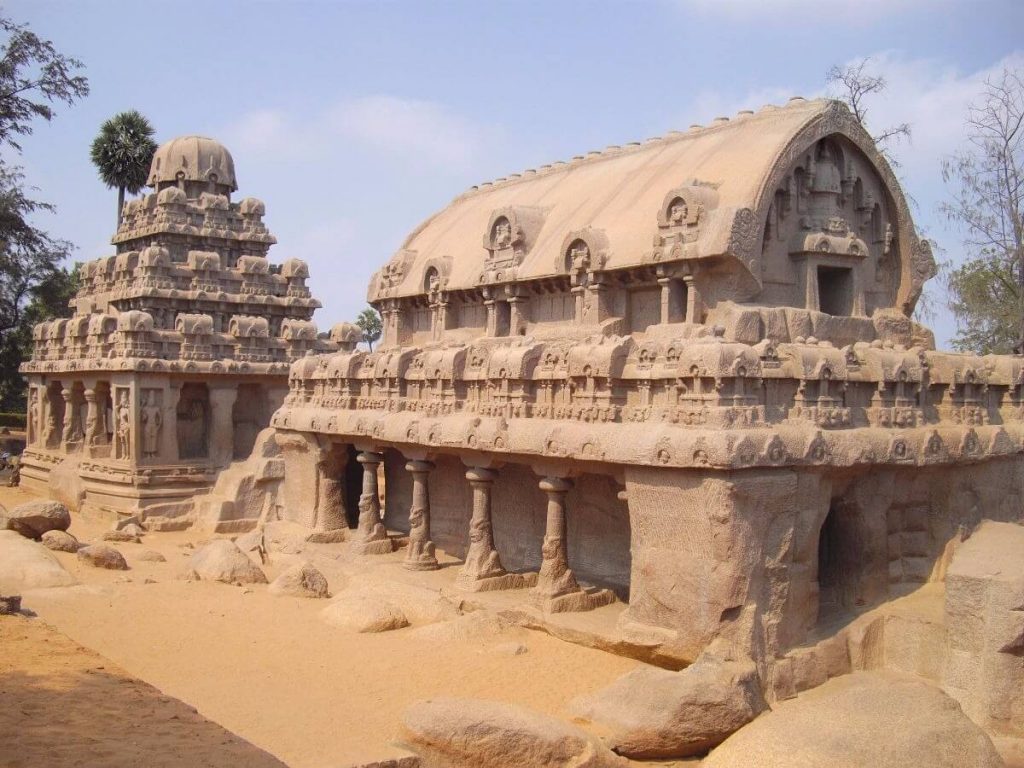
Hi Stephanie,
Thank you so much for this very informative and helpful info!! I’m a metal artist in Australia. I’m planning a research trip to Chhattisgarh in November this year to primarily learn about the art of Dhokra and the artisans and you’ve already answered a lot of my questions! Would you mind if I emailed you with some further enquiries? That would be so helpful, thank you! Sarra
Hi Sarra. I’ve your email address. I’ll send you an email so you’ll have mine 🙂
Can you please share shakeels contact? I am planning to travel to chitrakoot falls
have u got the shakeels contact no. ? tomorrow i need to travel there..
Of course, she had. She had also sent me a private message so I sent her. I don’t share contact numbers or emails in the comment for obvious privacy reasons.
If you had contacted me directly, I would also have given it to you. Saranya is not the admin of this website, I am!
Wooow! This is the best tourist blog. You have answered some questionS which are really important for other Indians too. This is so detailed one. And you are doing a lot of work in the area which is credible. Thanks for all the information.
Thank you Rushikesh. If I only give the information I find online it’s not very interesting. I consider I have to give my first-hand experience 😉